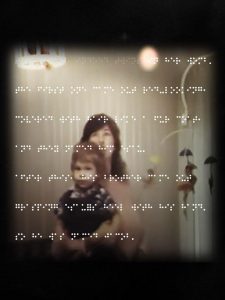Touch as Revelation in Pry
Danny Cannizzaro and Samantha Gorman’s 2014 I-pad novella Pry is an innovative fiction based around the possible movements of the touchscreen medium unlocking various video and audio input, making it a narrative that the reader interacts with by touch. In this tactile narrative, the reader can choose to immerse herself deeper into the psyche of the narrator by pinching the screen, or to look through the narrator’s eyes or unveil more text by ‘prying’ to advance the narrative. These movements have semantic relevance to the storyline and what element of it they reveal. Through this necessary tactile interaction, Pry is guided by the metaphor of the reader’s touch as sight.
The identification of Pry as an I-pad novella, including medium in its genre title, is significant, as it cannot be consumed outside of this touchscreen interface. The ‘pinch’ and ‘pry’ actions, one of which gives the piece its name, are part of the daily interactions that I-pad users would be familiar with in interacting with the medium. Pry relies on these actions that have become mundane and have ceased to signify in their second nature to the user, and then decontextualizes the actions into something that throws the reader outside of herself and her familiar routine and instead into the routine and mind of the protagonist. Each movement becomes meaningful and intimate. When the reader pinches the screen, she also closes the protagonist’s eyes and stirs up a refrain of compulsive words and thoughts that present themselves on a loop, effectively invoking “trauma…dormant until touched” (Jhave, Prying, 2014). These refrains take a form both as a “forced confessional” (Jhave), intrusive into the reader’s own psyche, but also something the reader has searched for. This changes the familiar, neutral surface of the screen into something that reflects back the reader’s everyday actions, creating a metaphor through touch.
Pry includes a chapter where Braille dots are displayed on the screen and in order to understand and progress through the chapter, the reader must swipe their finger along the screen to follow the dots. There is symmetry between action, words and images, as this movement emulates the real-life interaction that a Braille reader would have with the page when reading. Swiping along the text rewards the reader with a revelation of clips of flashback images with audio, presenting these as memories of the protagonist. Touch is also presented as sight in a revelatory sense here, as a blind reader can see and understand with touch, and the reader is now placed in this position–not only opening and closing eyes, but using the tactile sense to uncover a narrative in a new way. In the realisation that the Braille text presented is also biblical, the repeated swiping of the lines of text becomes mantra-like in hope of reaching revelation, in this case memories of childhood. There is some disconnect in this concept as the Braille is clearly smooth and digital as the screen itself, and not raised and actually legible to someone who could not see. However, the reader still needs to touch the screen in order to elicit meaning, and this gives each movement semantic relevance.



